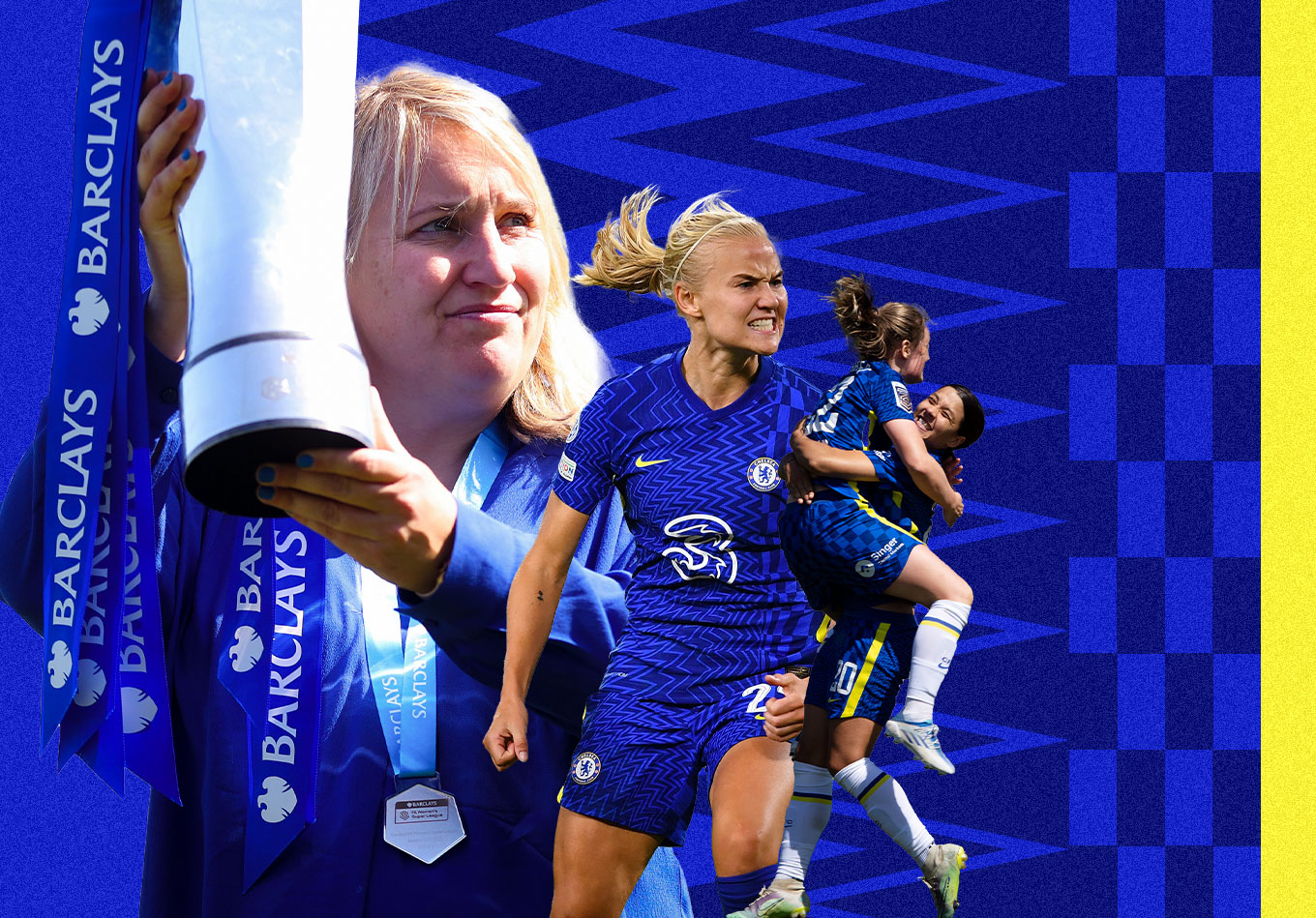As the sun shone down on Kingsmeadow, Emma Hayes was handed the microphone in the midst of Chelsea’s title-winning celebrations. “We had the highest expected goals,” she boomed out to the still full ground. “We had the lowest expected goals against.” Then she apologised: “I’m sorry for getting straight into the data”.
Hayes has long been known for her meticulous attention to detail, something brought to public attention through her punditry at the Euros, and it bore fruit again as Chelsea won their third consecutive Women’s Super League title. The league victory took Hayes’ total to five as well as one Spring Series trophy. No team has ever won three back-to-back WSL titles and the win over Manchester United on the final day took Hayes’ personal record to 114 WSL wins, 42 more than any other manager.
Here we take a look at some of the numbers behind Chelsea’s 2021-22 WSL win.
Tweaking and Changing
The final day of the WSL season did not start well for Chelsea. They knew they had to equal or better Arsenal’s result to retain the title but with Arsenal playing West Ham, the game against Manchester United felt like a must-win match. Instead, they found themselves losing 2-1 at half-time following a first 45 minutes that saw them easily played through by United’s front three of Leah Galton, Alessia Russo and Martha Thomas.
Emma Hayes has not been reserved about switching up her team this season, and the final day was no different. She brought on Bethany England and Ji So-Yun for Jonna Andersson and Sophie Ingle, switching from a 4-4-2 for a 3-4-3. It was the tenth game where she had made half-time substitutes and across the season Chelsea made 96 in total, with only Arsenal making more (97).
It also showed something Hayes has emphasised all year – her side’s tactical flexibility. Chelsea looked totally unphased with the formation switch, in part because they have been playing different versions of it all season. Emma Hayes had originally switched to a back three at half-time in last season’s Champions League final, when Chelsea were 4-0 down to Barcelona, but it took many by surprise when she continued it into the start of the WSL season in Chelsea’s opening match against Arsenal. If it was supposed to make them more defensively solid, there was little evidence of that when they conceded three goals at the Emirates. Hayes persisted, however, and it proved to be just under a third of their concessions all season.
Yet as the season progressed, Hayes began to move away from the back three. Chelsea became more and more flexible, leaving viewers squinting at team sheets trying to figure out what formation they would play. The final match of the season was the crowning moment for the versatility Hayes has used all year long, as the half-time reshaping saw Chelsea turn a 2-1 deficit in their favour to win 4-2 and secure the title.
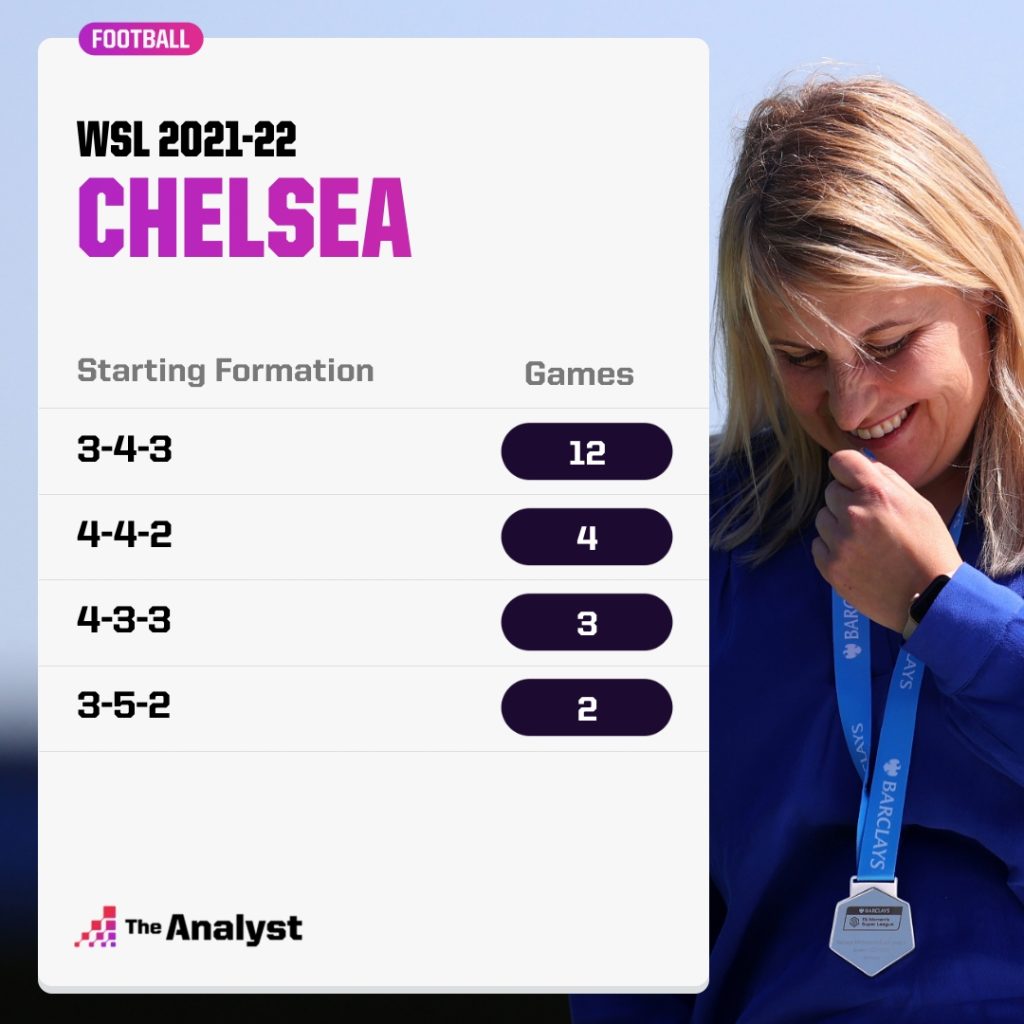
There have been subtler tactical changes from Hayes this season too. Chelsea have continued to press intensely with their PPDA rising ever-so-slightly from 9.8 to 10.1 this year. Perhaps more interestingly, the way other teams press in the WSL has changed around them. While Chelsea have maintained an intense pressing style, their rivals in this category Manchester City (8.4 to 10.1) Reading (9.7 to 13.6) have scale back the pressure a fair bit. As a result, Chelsea have gone from having the third lowest PPDA in 2020-21 to the joint-lowest in 2021-22, despite hardly changing themselves.
Their press continues to be effective at winning the ball back in dangerous situations. Chelsea’s 45 shot-ending high turnovers was the highest figure in the league this season.
Hayes’ side have played slightly more vertical this season compared to last, holding onto the ball for a shorter time per sequence on average and stringing fewer passes together per sequence. To say it’s a style change might be too far though, with those numbers till among the highest figures in the league. Compared to Arsenal and Manchester City though, the Blues have moved the ball faster, with the former two sides averaging almost a second longer in possession.

Tight at the Back
Despite some heavy beatings in other competitions, Chelsea ended the season as the most defensively solid side based on their expected goals against in the WSL. Although they did concede one more goal than Arsenal, their run of seven home clean sheets was essential to their success, and no mean feat given that they missed captain and centre-back Magda Eriksson for a large portion of that time period. They were particularly effective when it came to defending set pieces, conceding only 2.5 xGA from them all season, a league-low. Even though they allowed more shots from set pieces (47) than Manchester City and Arsenal, the xG conceded shows they were forcing opposition teams to take shots from low-value areas.

Ann-Katrin Berger missed out on the Golden Glove to Arsenal’s Manuela Zinsberger, but she came out on top as the best goalkeeper in the league in terms of goals prevented., with her saves worth almost two goals over the campaign.
Berger had a mixed season in a Chelsea shirt, sharing her minutes close to equally with Zecira Musovic, whilst her red card in a must-win game against Tottenham looked to have seriously jeopardised Chelsea’s title hopes. Yet despite that, she still proved herself to be the best shot-stopper in the league.
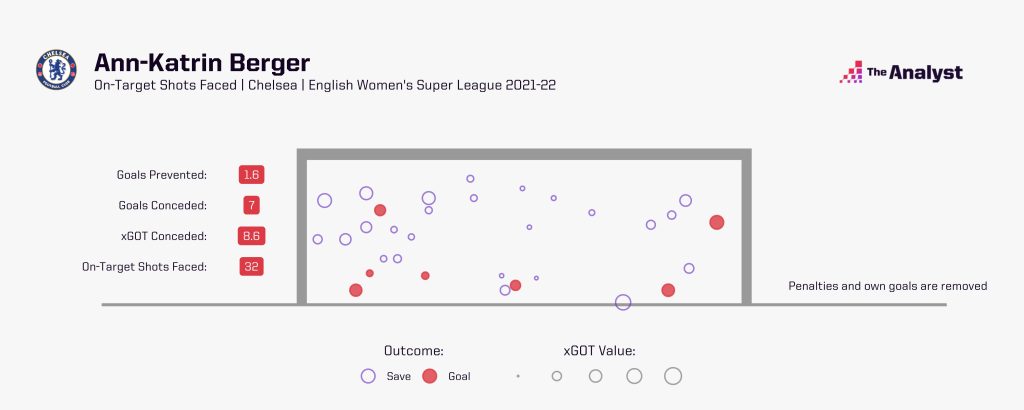
The Return of Reiten
Guro Reiten has been one of Chelsea’s standout players this season, but it could all have been so different. Reiten made only nine starts in 2020-21, despite having been essential to Chelsea’s 2019-20 title win. The signing of Pernille Harder along with Fran Kirby’s return to fitness saw her pushed to the bench. She became, however, a key beneficiary of Hayes’ tactical switch at half-time in the Champions League final, coming off the bench then and not looking back.
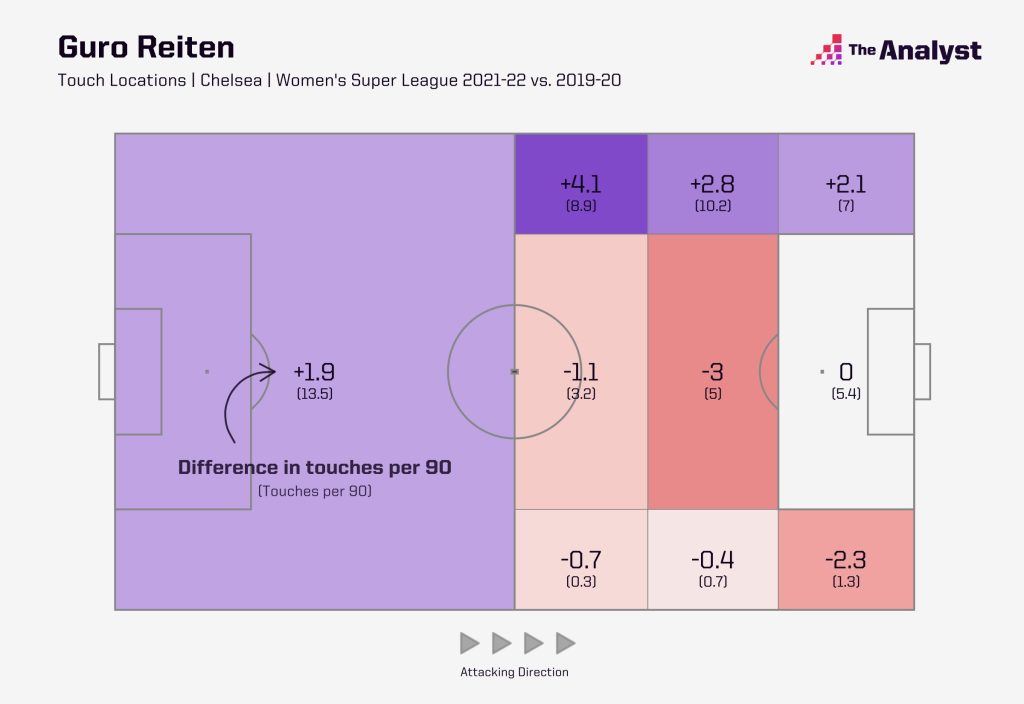
Utilised in what was previously an unfamiliar left wing-back role, Reiten has shone, recording seven goals and five assists, just one fewer goal contribution than she made in 2019-20. That ranks her joint seventh in the WSL this season, with Katie McCabe the only other player who is not a pure forward in the top ten.
Chelsea’s dominance on the ball obviously allows her to push much higher up the pitch than a traditional wing-back might, as seen by the fact that 104 of her open-play sequence involvements ended in shots, the sixth highest in the league. Meanwhile, the number of times she deceived goalkeepers with a floated ball into the side-netting suggested she was scoring those ‘crosses’ on purpose. The third goal against Manchester United on Sunday showed what a fantastic all-round asset she is for Chelsea as her movement into the box allowed her to finish unmarked. It seems hard to believe that over the summer, there were whispers she might be looking to move on.
“Sam Kerr, What Have You Done?”
You cannot talk about Chelsea this season without also talking about Sam Kerr. Kerr became the first player ever to score more than twenty goals in two consecutive WSL seasons, as she won the Golden Boot again. Since her WSL debut in January 2020, she has scored 42, more than anyone else during that time period.
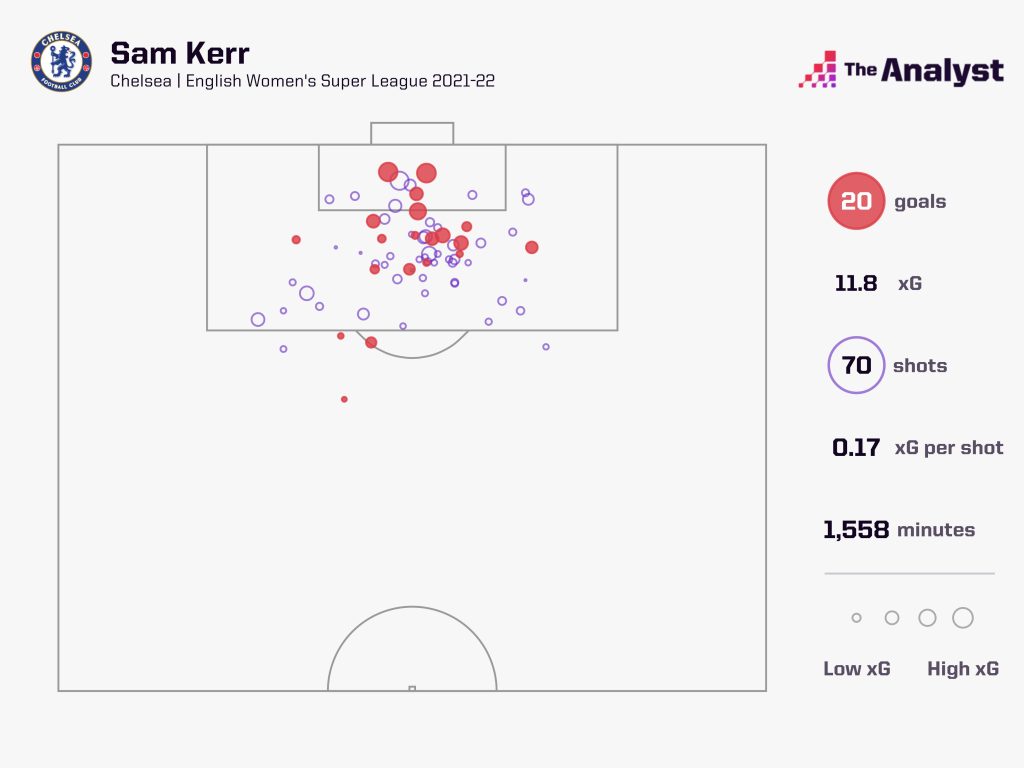
Kerr finished off her season in spectacular style, scoring a left-footed and then a right-footed volley against Manchester United to hit 20 goals for the season. She had the highest expected goals per 90 in the league with 0.69 and highest goals per 90 with 1.16. In the end, she scored 35% of her goals with her head, 20% with her left foot and 45% with her right foot.
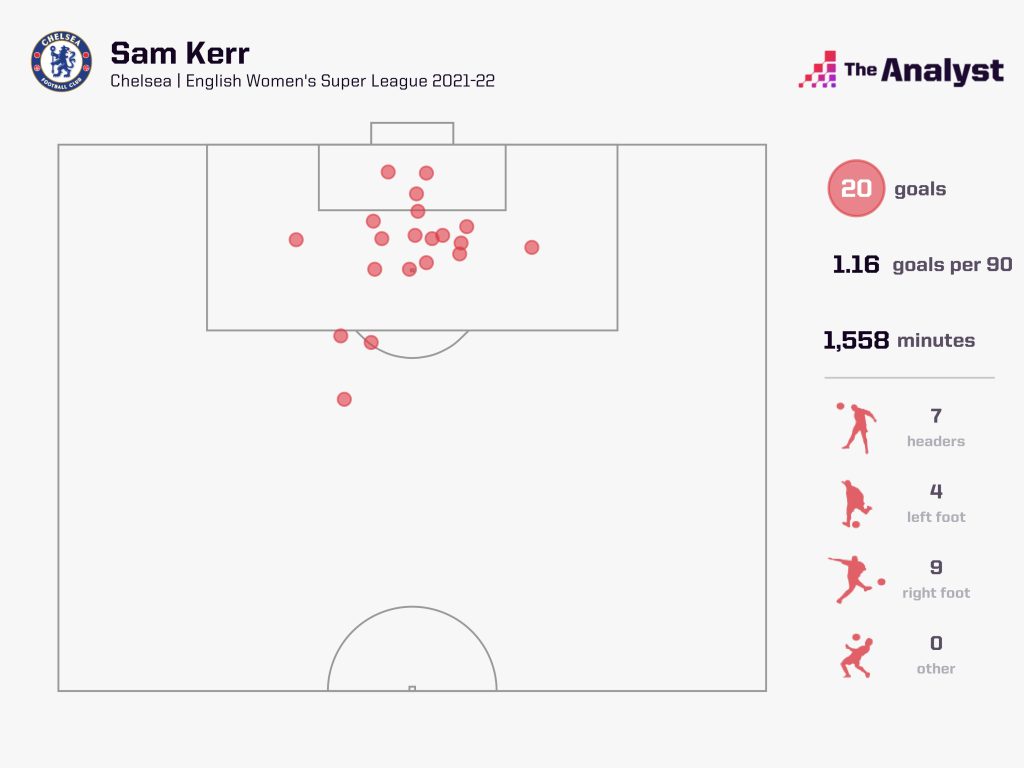
Not just a goal machine, she also tallied up four assists, and for every 100 open-play sequences she was involved in, almost five ended in goals, the highest in the league. Overall, she was involved in 29 of Chelsea’s goals this season, almost 50% of what they scored in the league. Whilst the volleys against Manchester United will surely go down as the most spectacular, her 92nd-minute winner against Aston Villa and her header when Chelsea were down to ten players away at Tottenham were the most important.
When she first arrived at Chelsea, some doubted whether she would be able to adjust to the WSL. She is currently the ninth all-time top scorer in the league after just over two seasons here, and is scoring at a rate of 0.92 goals per game. That is even faster than Vivianne Miedema.
All Together Now
No team wins a league title without using the full depth of their squad but Chelsea were forced to rely on all of their players as they looked to see out the title through their nine-game winning run at the end of the year. With Fran Kirby ruled out indefinitely with fatigue, Bethany England found herself back in contention to start again, racking up an expected goals per 90 figure of 0.65. Only Sam Kerr had a better average in the entirety of the WSL.
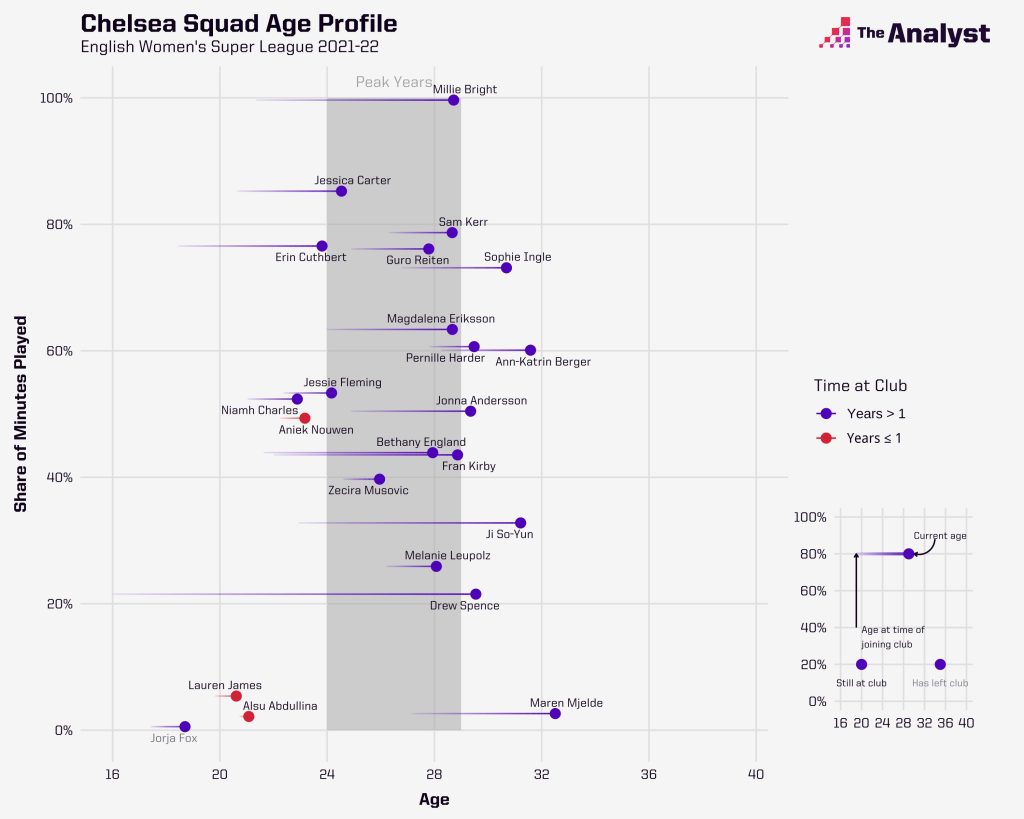
Meanwhile, the unavailability of Melanie Leupolz due to pregnancy saw Jessie Fleming get a much more prominent role in the squad, with her expected assists per 90 of 0. 24 ranking her eighth in the league overall. Fran Kirby had the highest xA per 90 in the league with 0.38, highlighting just how much of a miss she was for Chelsea.
Jess Carter became a stalwart in the Chelsea team, playing more minutes than she ever had previously in a WSL season, including when she was at Birmingham. This came after starting only three matches the year before, a mark of how much she has risen in Hayes’ estimations. She was rightly applauded for her ability to keep Lauren Hemp quiet in both Manchester City matches, demonstrating how much her one vs. one defending has improved. Her reading of the game has also been important to Chelsea, with her 3.2 interceptions per 1000 opposition touches the highest at the club and fifth highest in the league. Carter’s versatility saw her used all over the pitch, at points playing up to three different positions a game, making her an essential piece in Hayes’ plan to be as tactically flexible as possible.
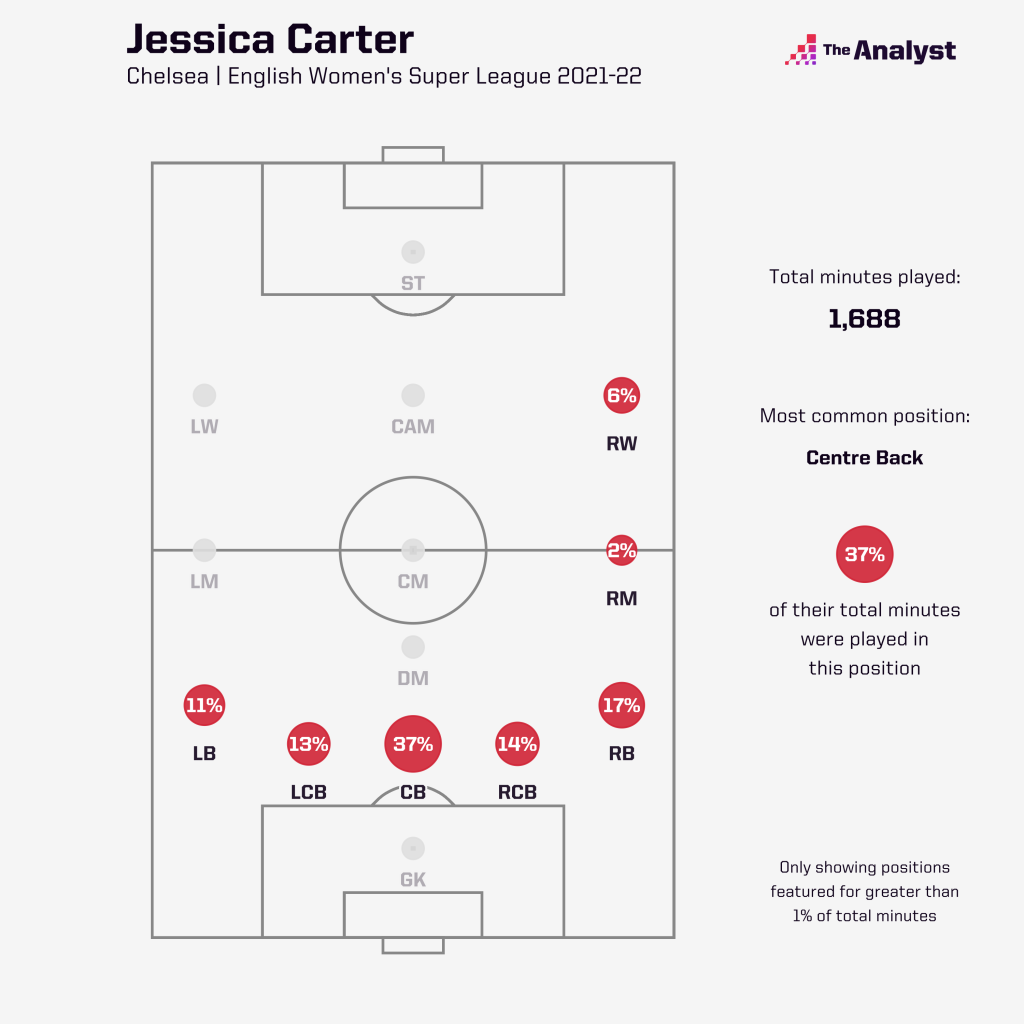
Aniek Nouwen also got significantly more minutes than many would have predicted at the start of the season thanks to both Chelsea’s preference for a back three and Magda Eriksson’s injury problems. Making 12 starts, Chelsea conceded only two goals when she was on the pitch.
Chelsea’s recruitment last summer was relatively limited with big signing Lauren James only playing 113 minutes this season, and the impact of sanctions on the team has cast a cloud on what they might be able to do this year. The departures of Ji So-Yun, Drew Spence and Jonna Andersson mean there are certainly holes in Chelsea’s squad, but the performances of their team players this year mean there is an incredibly strong base.
Enjoy this? Subscribe to our newsletter to receive exclusive content.
